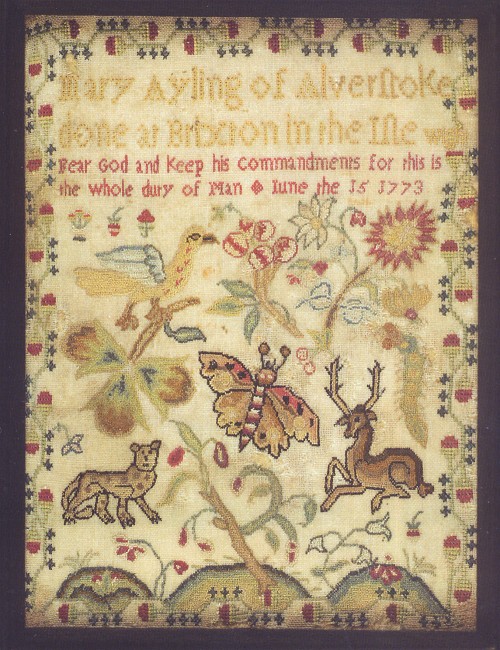
| ANNE WANNER'S Textiles in History / books |
| Micheŗl
& Elizabeth Feller, The Needlework collection : 2
by Elizabeth Feller new book packed with images of over 400 samplers, hussifs, pinballs, pockets and descriptions by Elizabeth Feller. There are 2 charted sampler projects in the jacket. 290 pages, in english, with many coloured photos, by Richard Holdsworth FRPS, Design and Layout N E E D L E P R I N T , in english, published by Needleprint, 2012, ISBN 9780955208669 http://needleprint.blogspot.ch/2012/09/now-shipping-micheal-and-elizabeth.html |
| The
book is devided into 15 chapters, each chapter with an
introducing text by Elizabeth Feller, and the samplers
are grouped according to these titles: - A Green and Pleasant Land - Quaker - Named Schools - Darning and Textures - Love of Letters - Bright and beautiful - Adam and Eve - All Creatures - History in Stitches - Wise and Wonderful - Over Borders - Across the Seas - Worship and Prise - Practical Pleasures - Latest Additions - Acknowledgements |
| In
the chapter of "Love of Letters" one
finds an interesting description of George MŁller and
his Bristol Orphan Houses, included is a photograph of
orphan girls in Bristol. More than ten very beautiful
samplers of this style with alphabets, in several sizes,
embroidered with red yarn are reproduced. Some of them
are anonymous, but there are also samplers with names on
them. Elizabeth Feller studied the records of the orphan
houses and in some cases also found out more about the
girls who made them. She also studied the small motives
on the samplers and traced some of them back to early
French pattern books published by DMC. The same chapter shows other similar samplers made in schoolrooms. And here as well, Elizabeth Feller researches many dates of the live of these girls. In this chapter one also finds samplers as basic as sampler can be. Elizabeth Feller writes about them, page 96: "It is very important to have examples from the whole range in a collection so that there is a context in which to set them. It also allows us to make comparisons and understand not only the range of abilities and ambitions or the individual stitchers, but also the sheer variety of teaching practices and teaching skills that were in existence at any one time." In the chapter "History in Stitches" Elizabeth Feller shows the sampler, made by Jane Austin the author in the year 1787 (page165). Here one reads not only about the author but also about the interesting history of the sampler itself. So the book represents a beautiful picture book with numerous excellent photos of samplers, and there are also many sensitive and often very touching texts. So the book becomes a rich and interesting source in many different directions. |
| F
241 Mary Ayling, Age 14, 1773, 14.5 x 19.5 cm (page 143) |
 |
| The
following text explains the above sampler: "Baptized
on 25 March 1759, Mary was the daughter of James and Mary
Ayling. On her sampler she tells us that she was of
Alverstoke and indeed that is where she was born. Her
birthplace is situated near the port of Gosport and,
perhaps better known, Portsmouth in Hampshire, on the
south coast of England. She also tells us that she worked
her sampler at Brixton, on the Isle of Wight, which is
just across the Solent from er birthplace. Brixton is now
sometimes called Brightstone. Within a very disciplined border of strawberries, Mary has worked her bright creatures - a stag, bird, butterfly, caterpillar and leopard that would not look out of place on a sampler or panel worked a hundred years earlier. All has been worked on a linen ground using petit point, cross stitch and eyelet." |
| On the blog
"needleprint" of the book designer Jacqueline
Holdsworth there one found a discussion about an
index to all the different samplers, which would be very
helpful. Jacqueline Holdsworth tells that it is a 300 plus page hard cover book with at least 3 times more than they have ever put into one book. "Never before have you seen a needlework collection like this. Over 400 samplers dating from the 18th to the 20th century plus pinballs and pockets are shown in full colour in this second of a two volume set. Thanks to Micheal & Elizabeth Feller, your opportunity has just arrived!" There are charts for two samplers inside the jacket cover. But some of you will wonder why for the first time there is no index in our book. Well, there was an index and I worked for the best part of a month creating it. Then I threw it away! I saw some recent exquisite aquisitions made by MicheŠl and Elizabeth Feller and decided there and then you would prefer to have images of those samplers instead of an index. But why not both, you might ask? The answer is I was always designing with a weight on my mind - and that weight with a book mailer had to be less than 2 kilos. In fact the book weights 1.95 kilos in a book mailer. It was that close a call. comment on the blog "Needleprint" by Marty G 29 September 2012: Your explaination for leaving out the index makes sense. Maybe you can make it available on your website for download. I am sure those of us who have purchased the book would be happy to purchase the download. and answer of Jacqueline: Dear Marty - that sounds an excellent idea and of course we would make it available for free! Thank you. |
| home content | Last revised 9 October, 2012 |